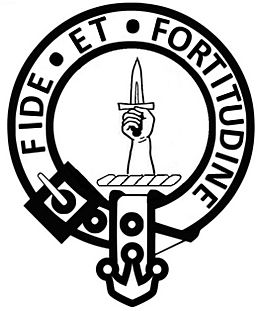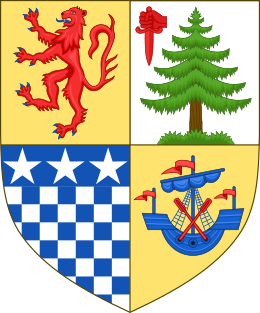Clan Shaw facts for kids
Quick facts for kids Clan Shaw |
|||
|---|---|---|---|
| Mac Ghille Sheathanaich | |||

Crest: A Dexter Arm, the hand holding the dagger, pale, proper
|
|||
| Motto | Fide et fortitudine (By fidelity and fortitude) | ||
| War cry | "Na Bean Ris A Chat" (Touch not the cat) | ||
| Profile | |||
| Region | Highland | ||
| District | Strathspey | ||
| Plant badge | Red whortleberry | ||
| Pipe music | The Rothiemurchus Rant, The Shaws March | ||
| Chief | |||
 |
|||
| Landon Shaw of Tordarroch | |||
| Historic seat | Doune of Rothiemurchus | ||
|
|||
|
|||
|
|||
Clan Shaw is an old Scottish clan from the Highlands. They are part of a larger group of clans called the Chattan Confederation.
Contents
A Look Back: Clan Shaw's History
Where Did Clan Shaw Come From?
Clan Shaw started with a man named Shaw MacDuff. He was the son of Duncan, who was like a powerful lord (called a Thane or Earl) in Fife. Duncan was related to an old Scottish king, Kenneth MacAlpin.
King Malcolm IV of Scotland made Shaw MacDuff the keeper of Inverness Castle. This was a very important royal castle. Shaw's family became known as the Mhic anToiseach. This means "sons of the Thane." They supported the king and grew stronger near Inverness.
In 1263, Shaw's grandson, Shaw Macwilliam, gained land in Rothiemurchus. His son, Farquhard, faced problems with a strong neighboring clan, the Comyns. To get help, Farquhard made an alliance with Clan Donald. He married Mora, the daughter of Aonghas Mór, Lord of Islay.
Farquhard's son was Angus Mackintosh, who became the sixth chief of Clan Mackintosh. He married Eva, whose father was the chief of the Clan Chattan. Eva's second son, John-Angus, became the very first chief of Clan Shaw.
Fighting for Scotland's Freedom
The Clan Comyn feud led the Chattan Confederation to support Robert the Bruce. They fought alongside him at the famous Battle of Bannockburn in 1314. This battle was a big win for Scotland's independence. Clan Shaw also joined Scottish invasions of England in 1318 and 1319.
Clan Shaw in the 1300s
The second chief of Clan Shaw was Shaw Macghillechrist Mhic Iain. He was the great-grandson of Angus Mackintosh and Eva. People called him Sgorfhiachlach, which means "bucktooth." He grew up with his cousins at Moy Hall, the home of the Mackintoshes.
It is believed he was at the Battle of Invernahavon in 1370, fighting against the Clan Cameron. In 1391, Shaw was chosen to lead the Clan Chattan on a raid into Angus. This raid was led by Alexander Stewart, Earl of Buchan, also known as the "Wolf of Badenoch."
In 1396, Shaw was picked to lead the Clan Chattan in a special fight. This was the Battle of the North Inch, a trial by combat against the Clan Cameron. It happened in front of a crowd that included King Robert III of Scotland and the Prince of France.
Clan Shaw in Later Centuries
James Shaw of Rothiemurchas was killed in a battle called the Battle of Harlaw in 1411.
Aedh, the grandson of Shaw "Bucktooth," settled in Tordarroch in 1468. His home was in an important spot near the River Nairn. He and his followers became known as the "Clan Ay."
In 1543, Angus MacRobert of Tordarroch signed an agreement to unite and manage the Clan Chattan. This was signed in Inverness. Shaw of Tordarroch signed a similar agreement again in 1609. The clan grew stronger. By 1691, Duncan Shaw, Laird of Crathienaird, became a high-ranking official for the Earl of Mar.
Over time, different branches of Clan Shaw developed. Some of these include the Shaws of Tordarroch (Clan Ay), the Shaws of Dell, and the Shaws of Dalnavert. Another important branch is the Mackintosh-Shaws of Mar, who are now known as Clan Farquharson.
The 1700s and Jacobite Risings
In 1715, Mackintosh of Borlum called on the Clan Chattan to support the Jacobite cause. This was a rebellion to bring the Stuart family back to the throne. The Shaw group was led by Robert, the younger of Tordarroch, and his brother Angus. The Shaws were known for being well-organized, well-equipped, and brave.
Robert and Angus were put in prison after the rebellion failed. Robert died soon after being released in 1718. Angus was sent to Virginia but was pardoned in 1722. Because of his experiences and his brother's death, Angus refused to call his clan to fight in the Jacobite rising of 1745. However, many Shaws still supported the Jacobite Stuarts, like James Shaw of Crathienaird.
Lady Anne Farquharson-MacKintosh called all of Clan Chattan to fight for the Jacobites. Two of her most trusted leaders were James Shaw and John Shaw of Kinrara.
Clan Shaw's Chiefs
In 1970, Major Charles John Shaw of Tordarroch was officially recognized as the chief of Clan Shaw. He was the grandfather of the current chief. This family line goes all the way back to the ancient Earls of Fife.
The 22nd Chief of Clan Shaw, John Shaw of Tordarroch, passed away in Spain in 2017. His son, Iain Shaw of Tordarroch, is now the 23rd Chief of Clan Shaw.
Clan Castles
- Doune of Rothiemurchus: This is a mansion from the 1700s, located two miles south of Aviemore. It replaced an older castle. The Shaws, Mackintoshes, and Dallases of Cantray all held land here. James Shaw of Rothiemurchus was killed at the Battle of Harlaw in 1411.
- Tordarroch Castle: Seven miles south of Inverness, this was once a strong tower, but not much of it remains today. The Shaws held this castle from 1468. Later, Tordarroch House was built in its place.


